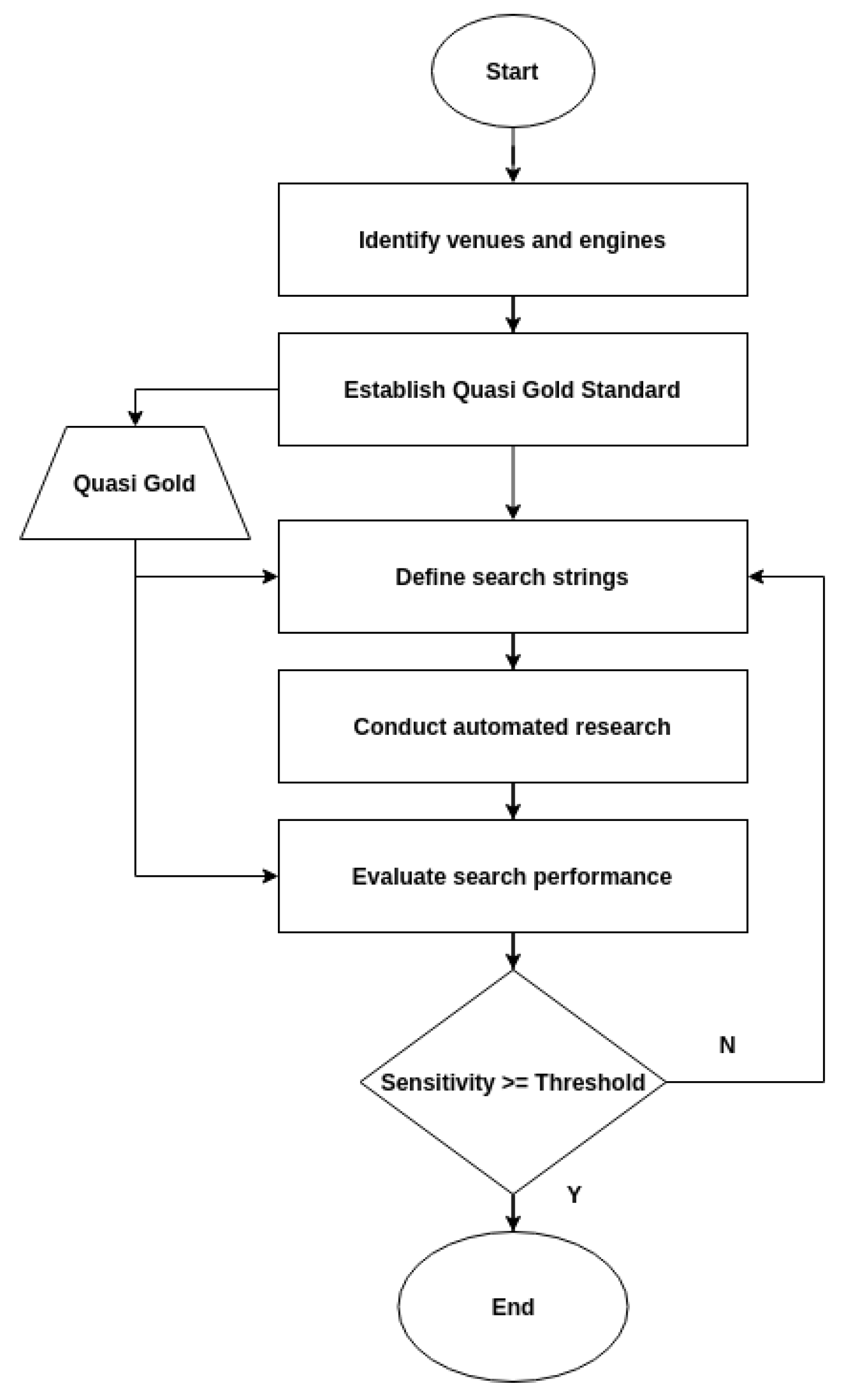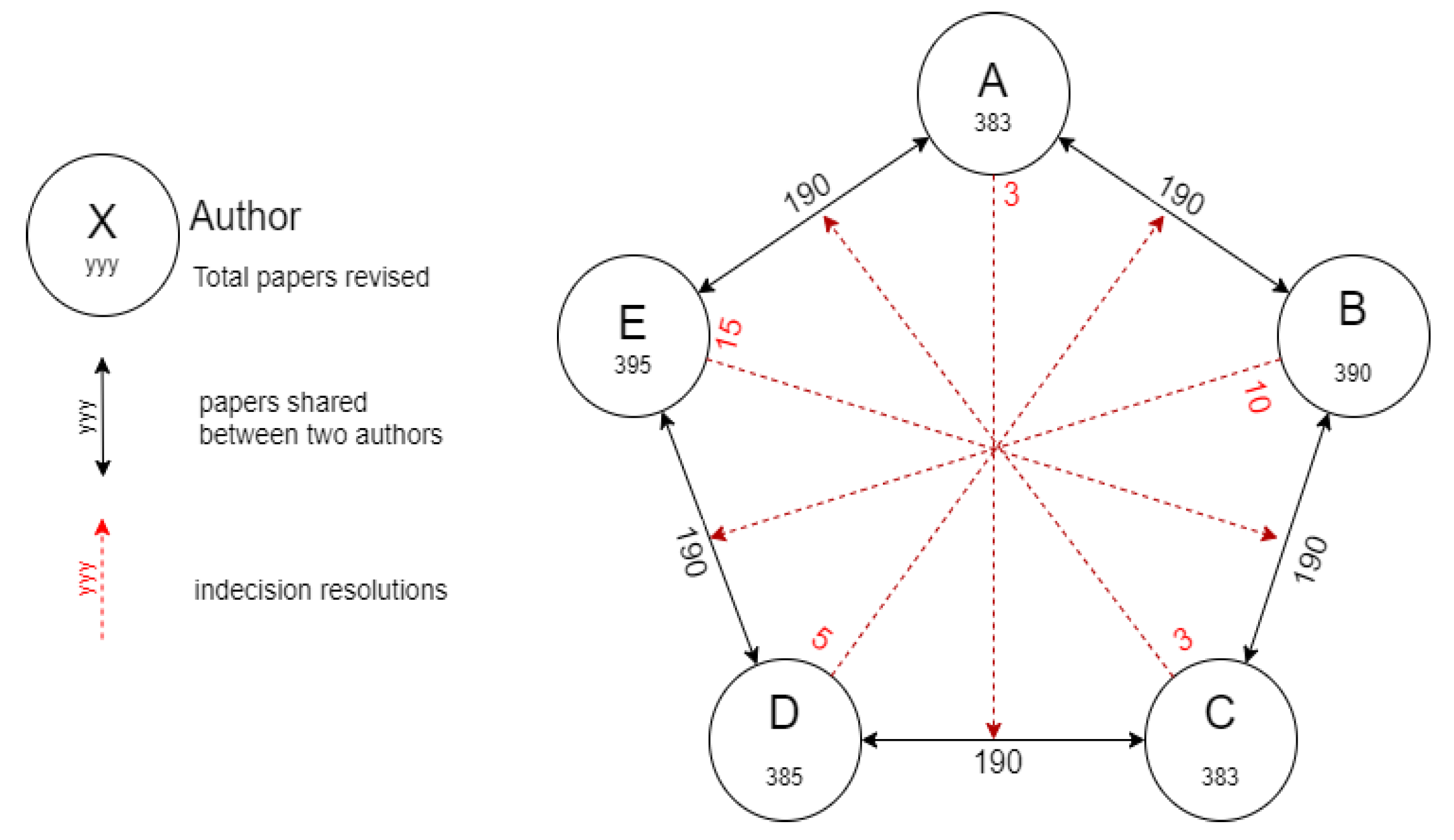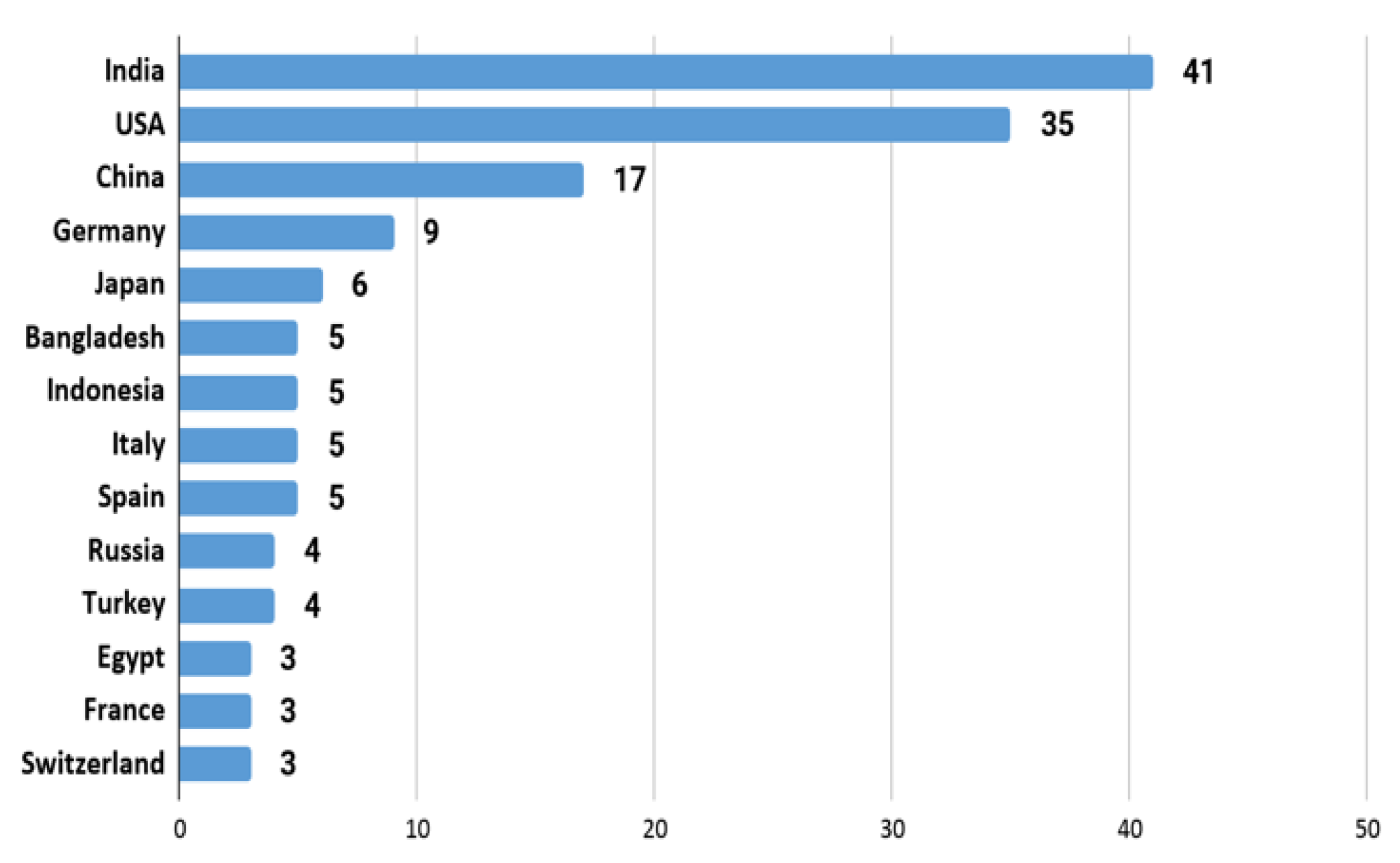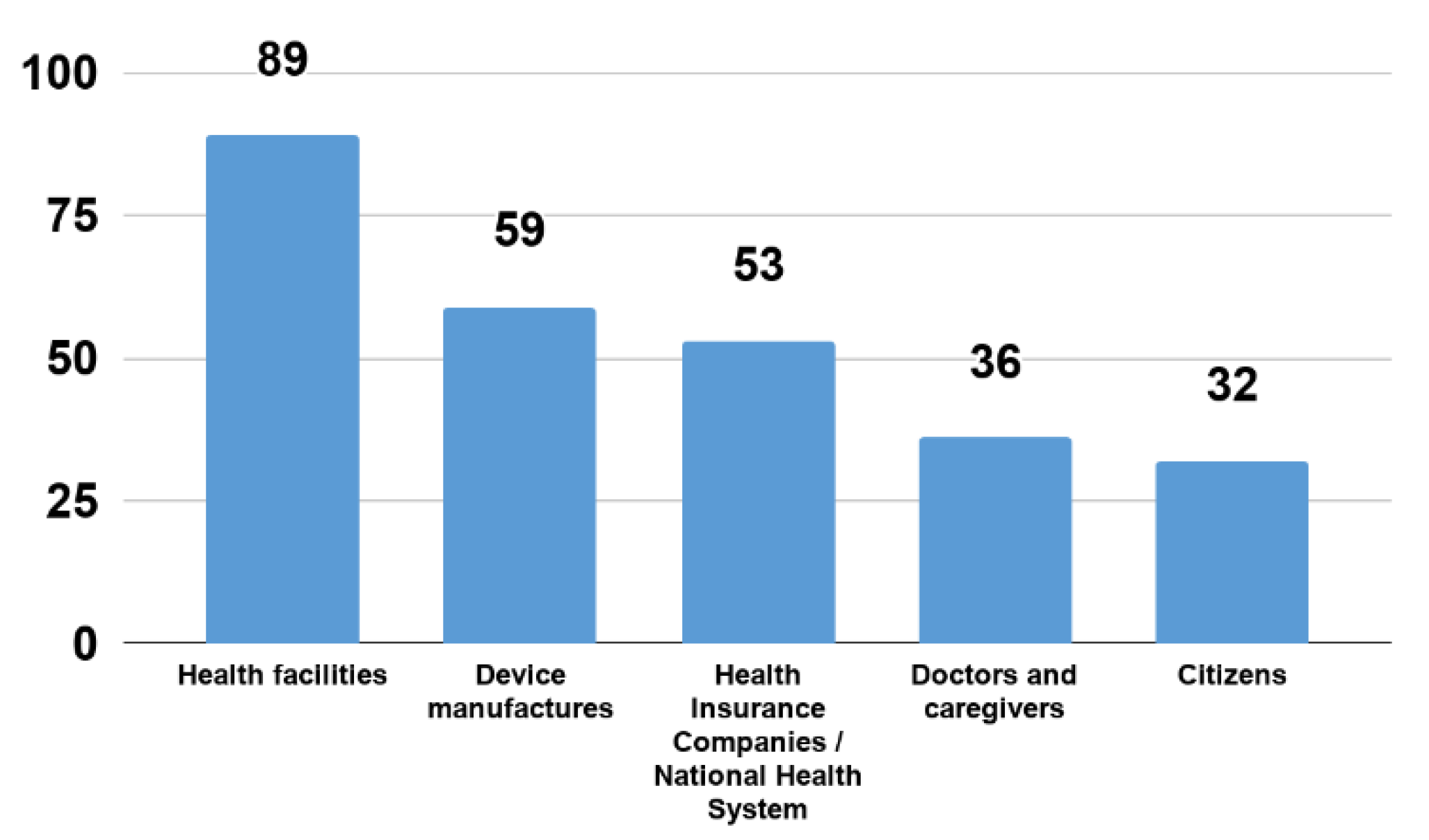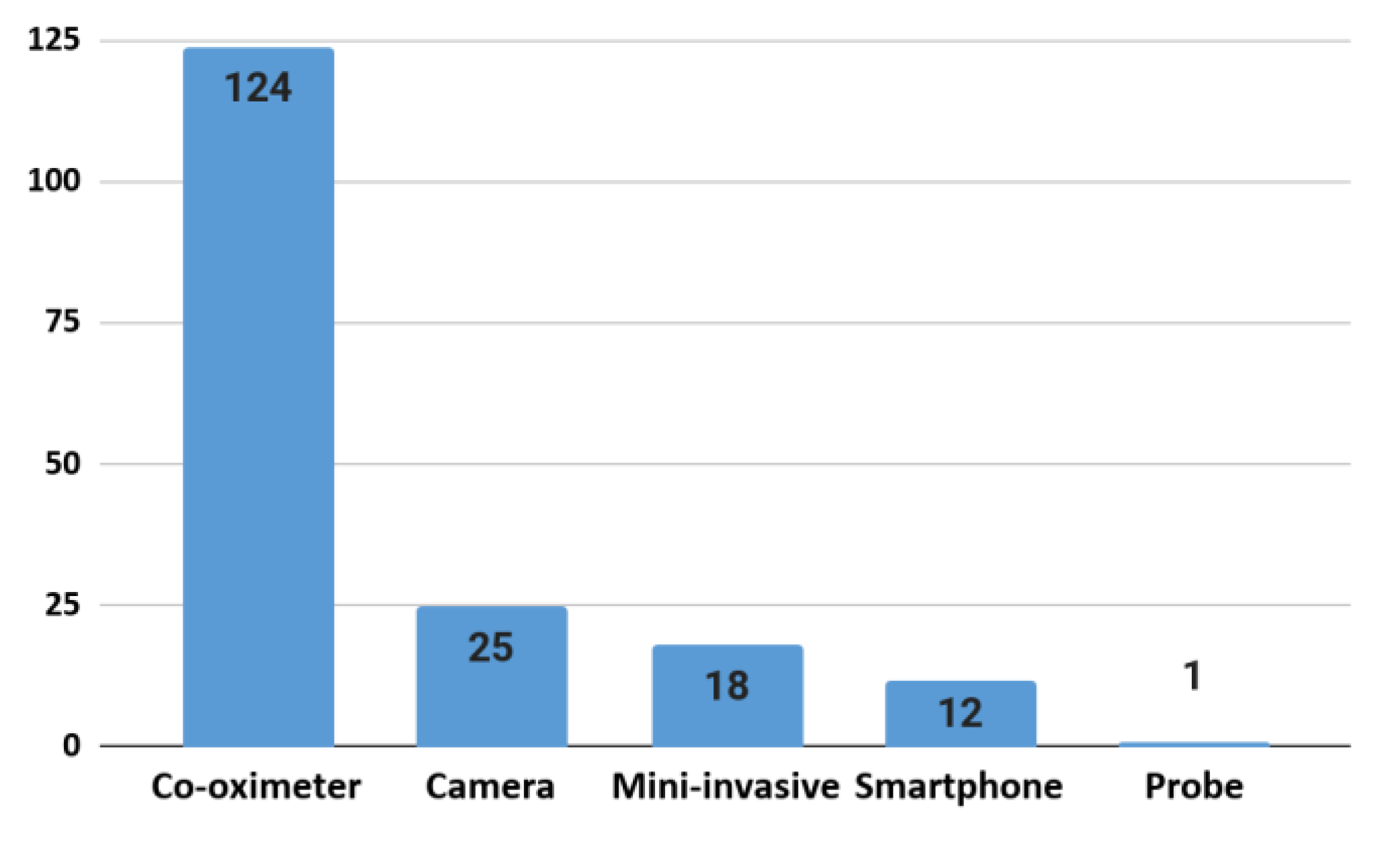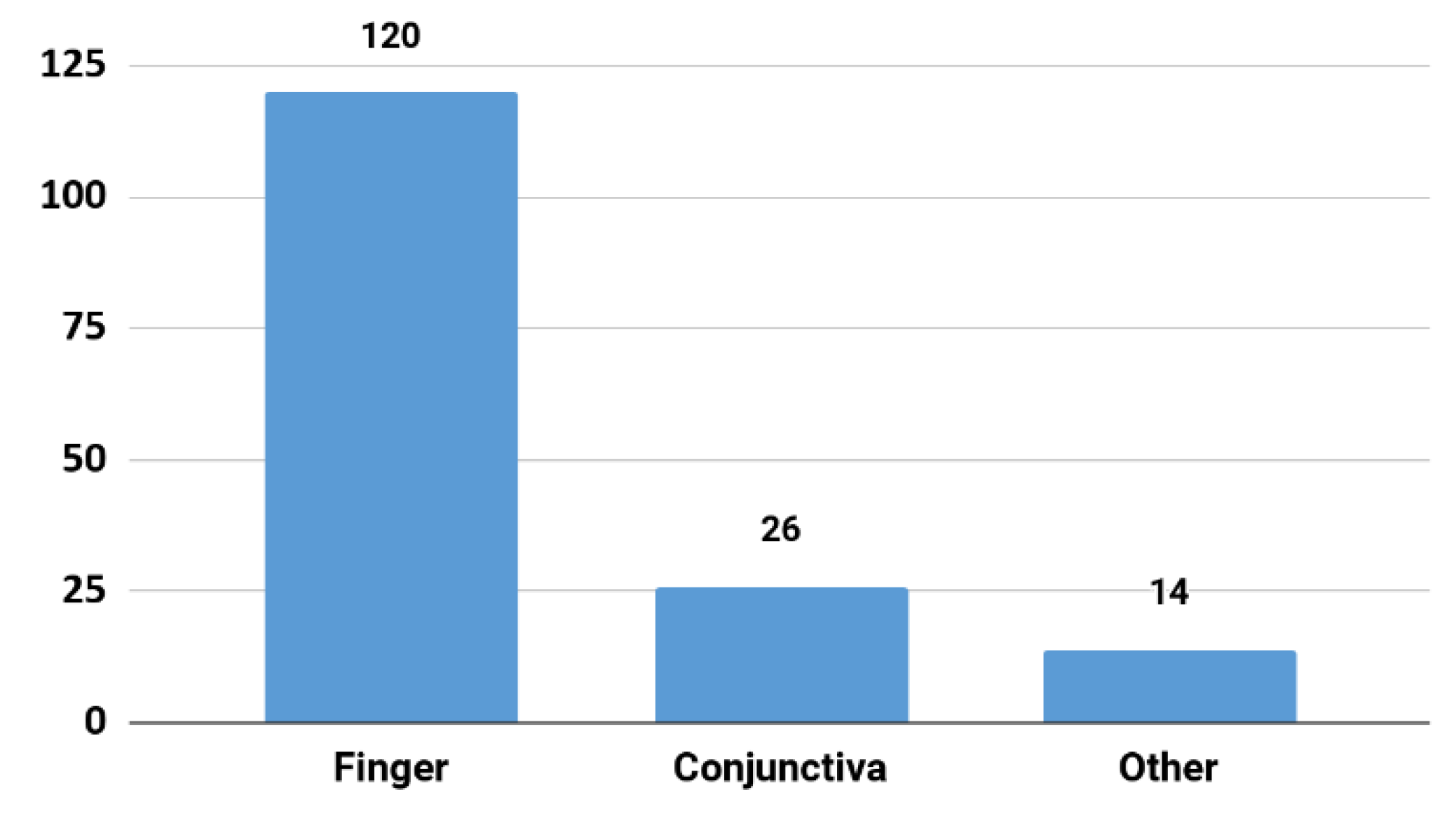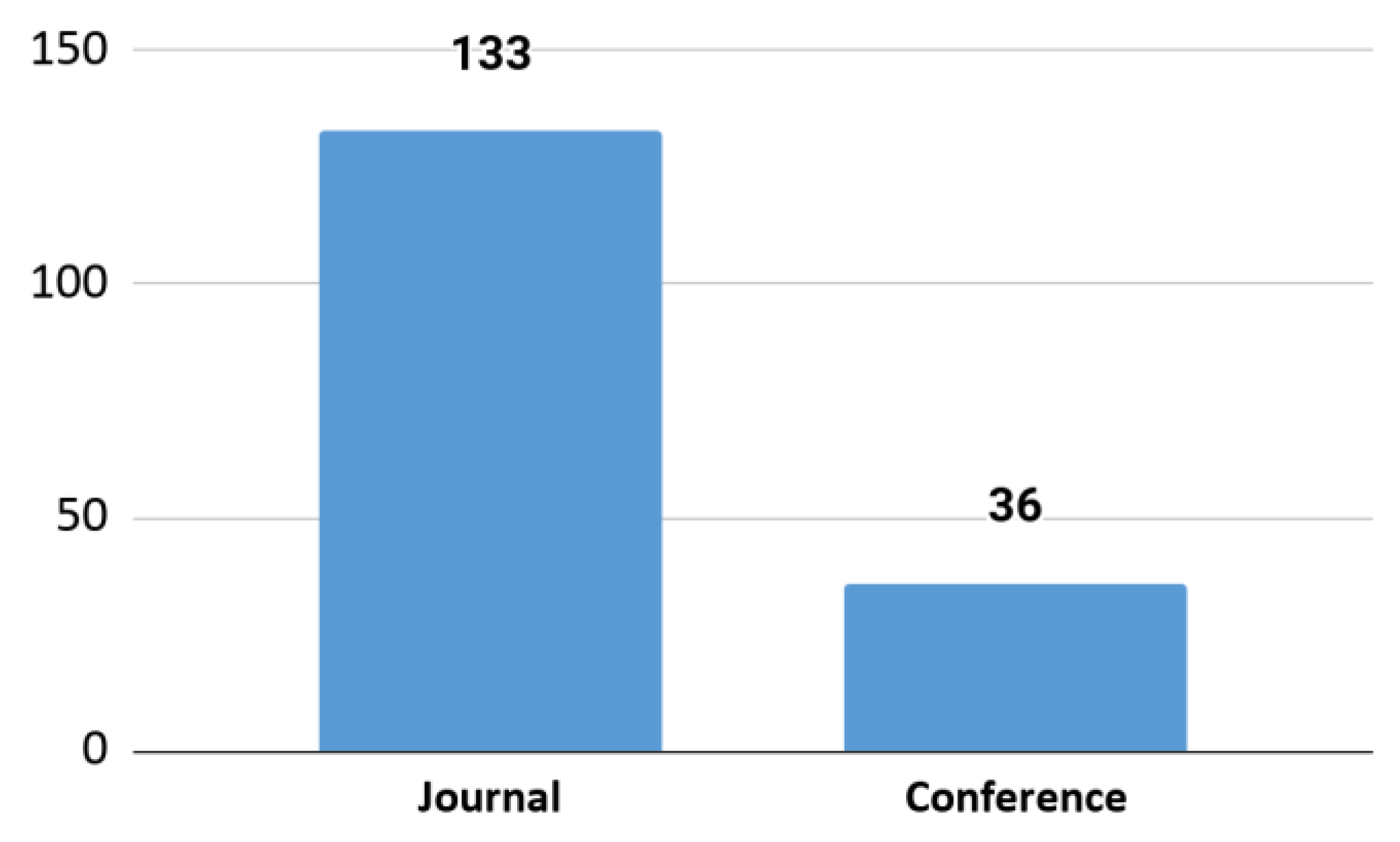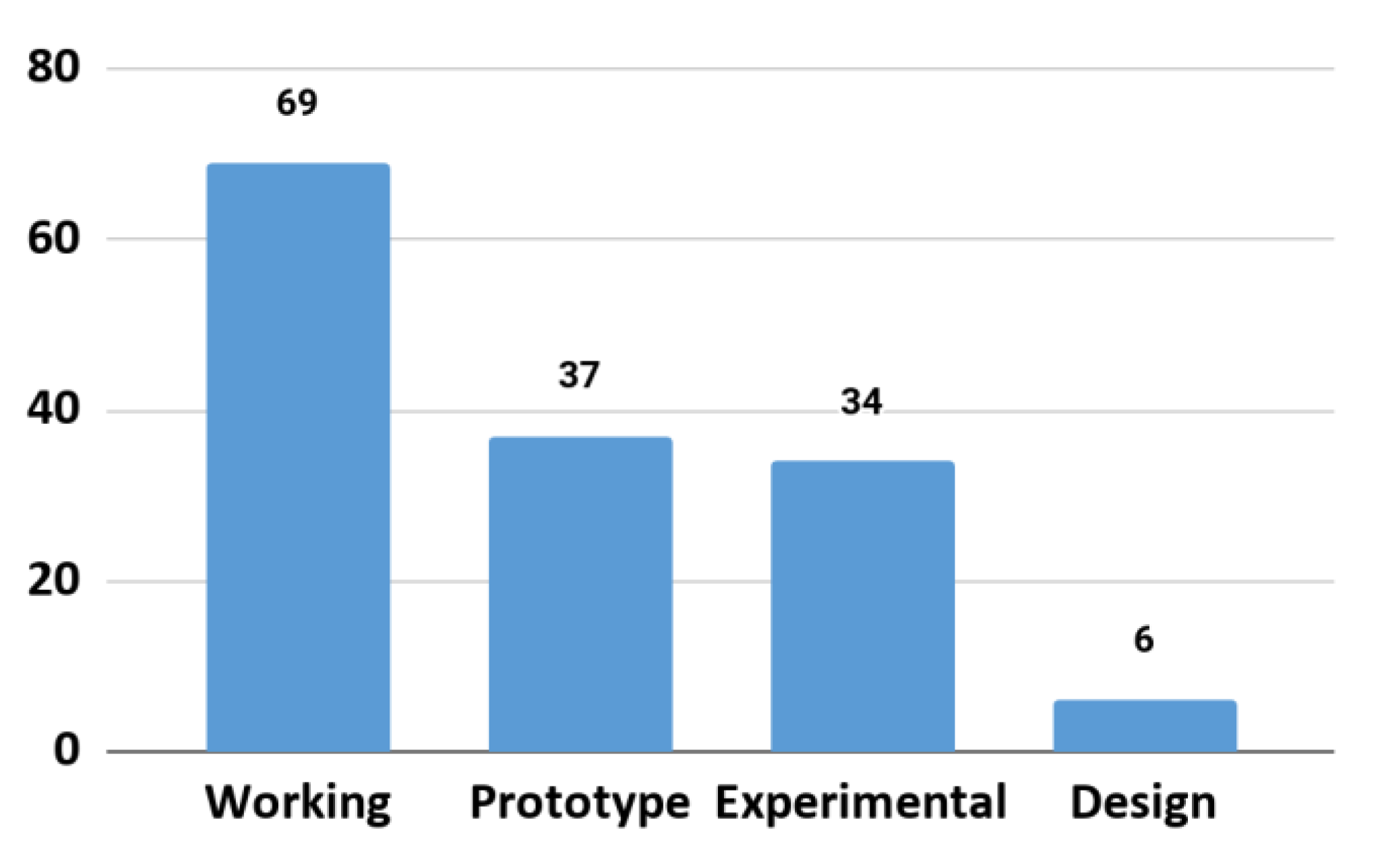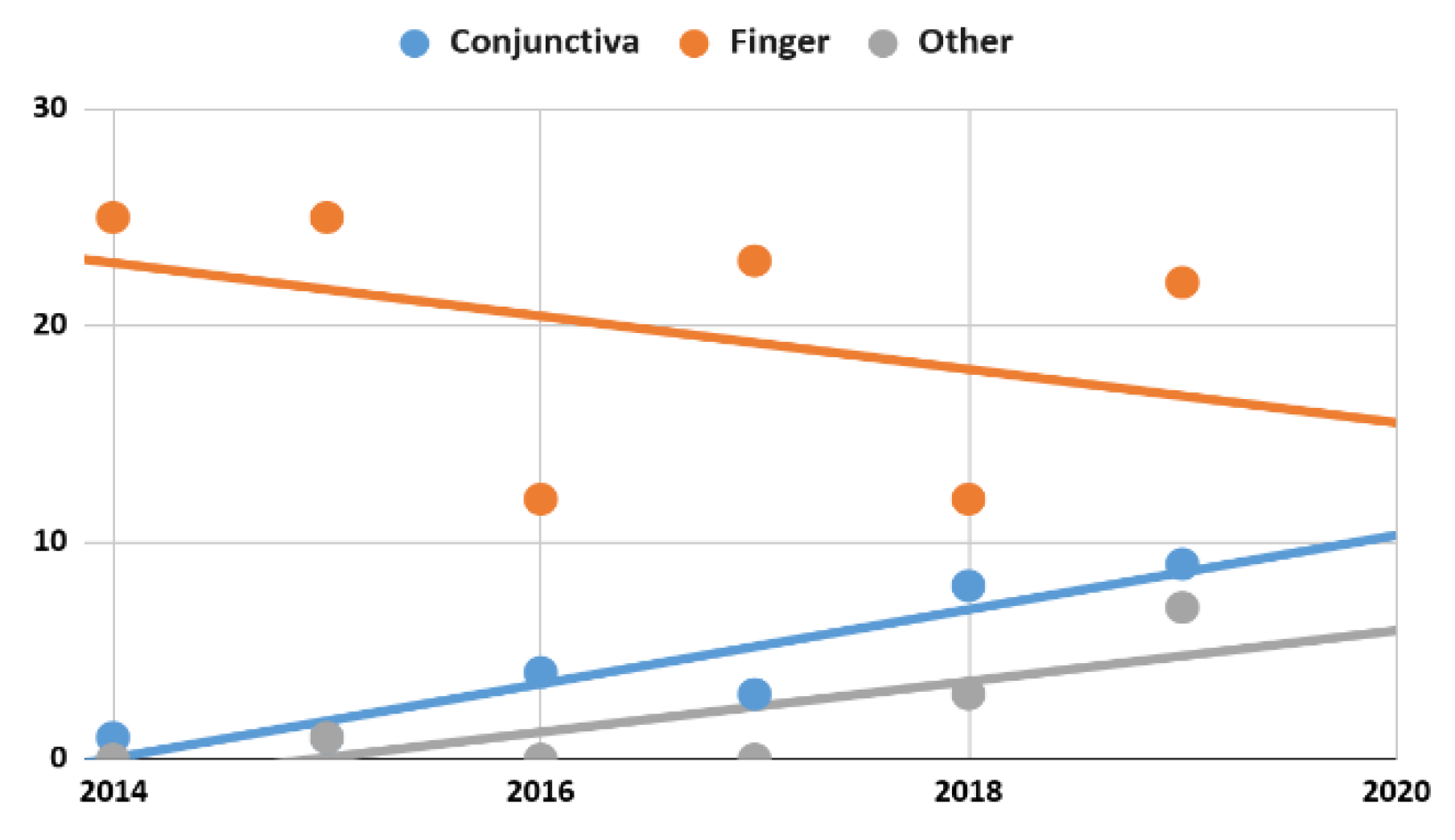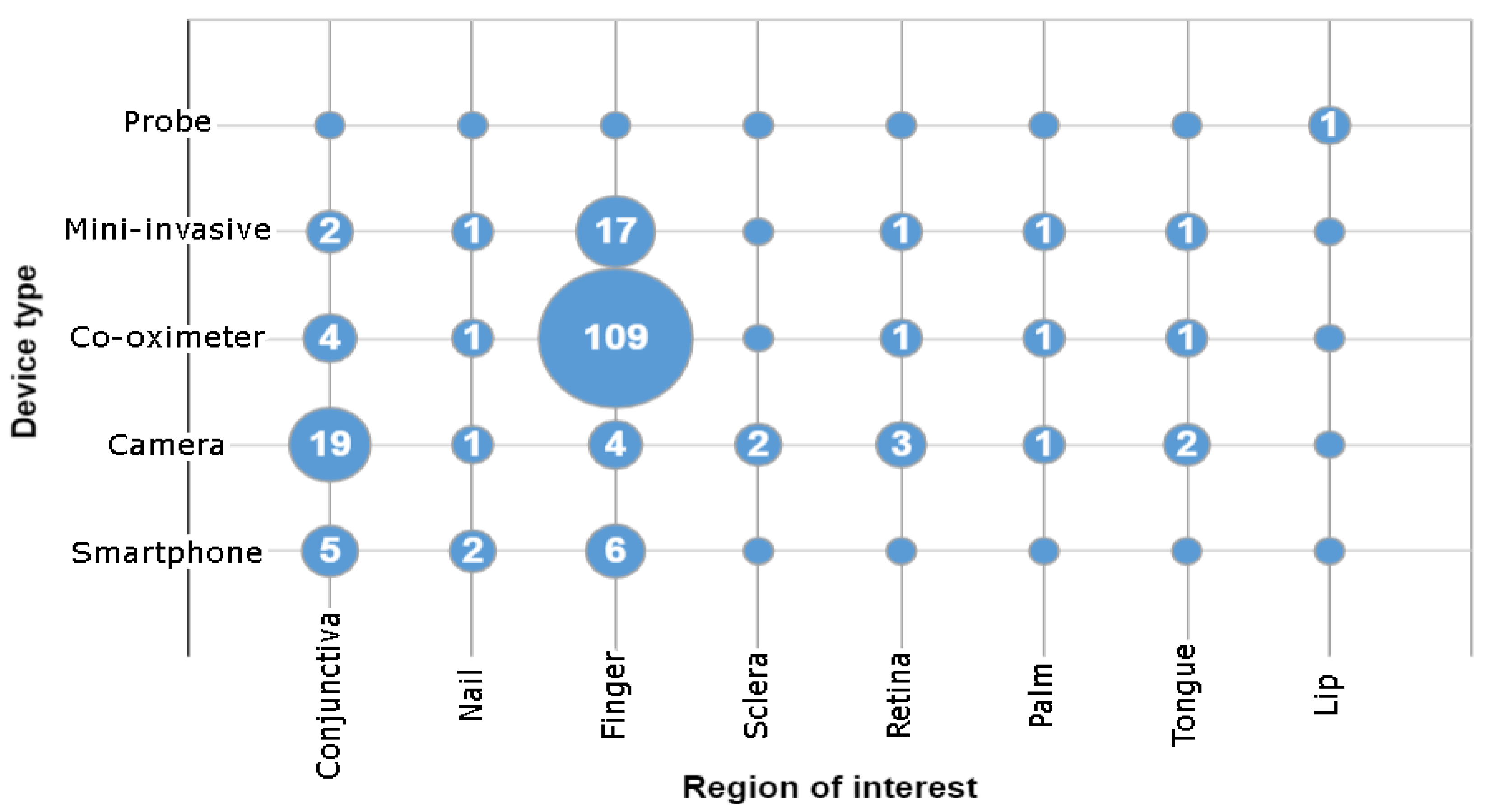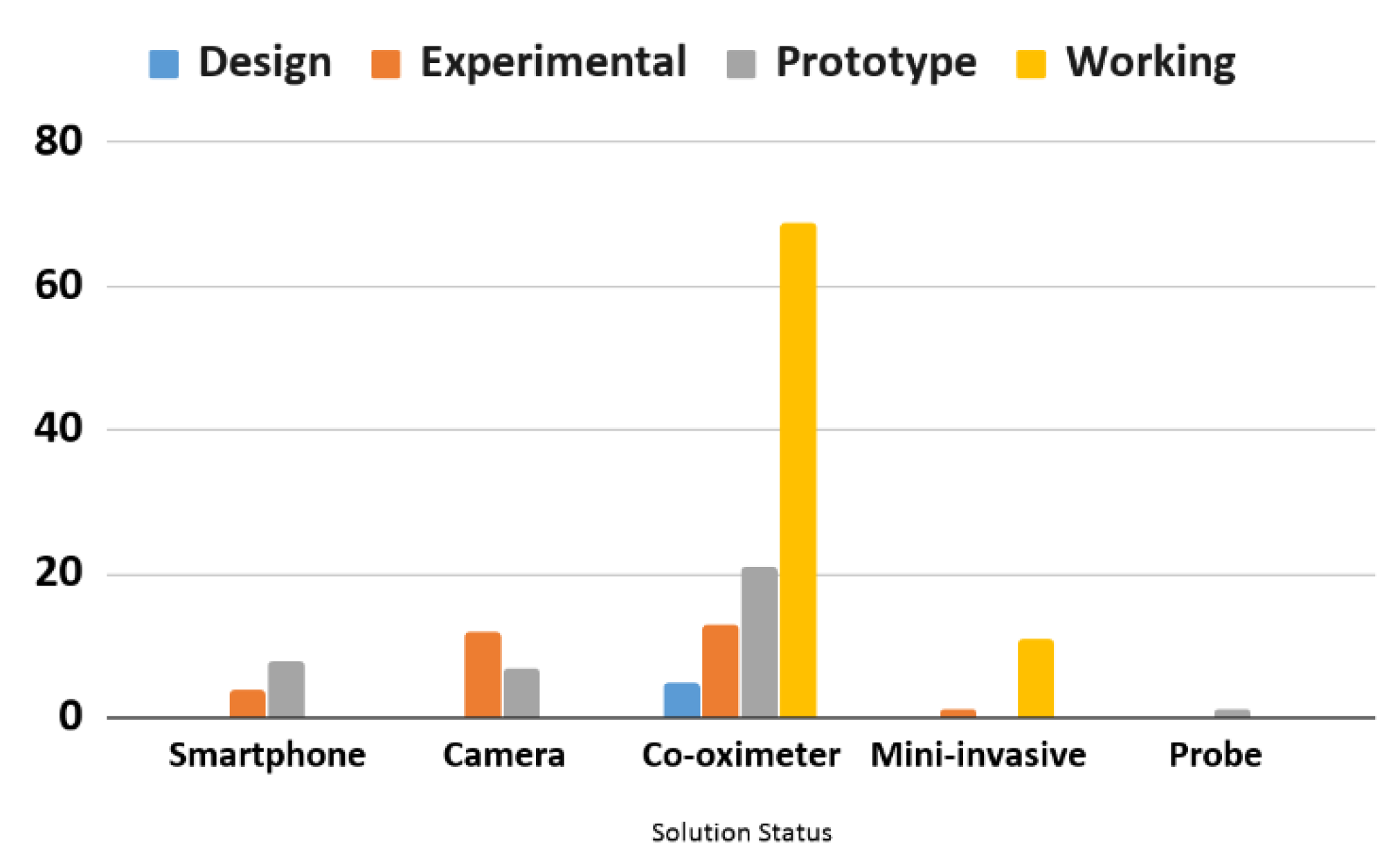- A1.
Reich, C.A.; Glaum, A.; Weimann, J. 24 Hour-Accuracy of Continuous Non-Invasive Hemoglobin Measurement By Pulse Co-Oximetry (SPHB) In ICU Patients With Different Inflammatory States. In Proceedings of The Intensive Care Medicine; Springer 233 Spring St, New York, NY, USA, 2014; Volume 40, pp. S281–S282.
- A2.
Pajares, A.J. A Comparative Study of Three Non-invasive Systems for Measurement of Hemoglobin with HemoCue System Having Coulter LH750 as Reference Value. Hematol. Transfus. Int. J. 2015, 1, 68–74.
- A3.
Chen, Y.-M.; Miaou, S.-G. A Kalman Filtering and Nonlinear Penalty Regression Approach for Noninvasive Anemia Detection with Palpebral Conjunctiva Images. J. Healthc. Eng. 2017, 2017, e9580385, doi:10.1155/2017/9580385.
- A4.
Dimauro, G.; Caivano, D.; Girardi, F. A New Method and a Non-Invasive Device to Estimate Anemia Based on Digital Images of the Conjunctiva. IEEE Access 2018, 6, 46968–46975, doi:10.1109/ACCESS.2018.2867110.
- A5.
Bauskar, S.; Jain, P.; Gyanchandani, M. A Noninvasive Computerized Technique to Detect Anemia Using Images of Eye Conjunctiva. Pattern Recognit. Image Anal. 2019, 29, 438–446, doi:10.1134/S1054661819030027.
- A6.
Phillips, M.R.; Khoury, A.L.; Bortsov, A.V.; Marzinsky, A.; Short, K.A.; Cairns, B.A.; Charles, A.G.; Joyner, B.L.; McLean, S.E. A noninvasive hemoglobin monitor in the pediatric intensive care unit. J. Surg. Res. 2015, 195, 257–262, doi:10.1016/j.jss.2014.12.051.
- A7.
Bevilacqua, V.; Dimauro, G.; Marino, F.; Brunetti, A.; Cassano, F.; Di Maio, A.; Nasca, E.; Trotta, G.F.; Girardi, F.; Ostuni, A.; et al. A novel approach to evaluate blood parameters using computer vision techniques. In Proceedings of the 2016 IEEE International Symposium on Medical Measurements and Applications (MeMeA), Benevento, Italy, 15–18 May 2016; pp. 1–6.
- A8.
Kumar, R.; Ranganathan, H. A novel classification scheme for non-invasive hemoglobin measurement methods. J. Theor. Appl. Inf. Technol. 2014, 67, 461–467.
- A9.
Hasan, M.K.; Sakib, N.; Field, J.; Love, R.R.; Ahamed, S.I. A novel process to extract important information from invisible video captured by smartphone. In Proceedings of the 2017 IEEE Great Lakes Biomedical Conference (GLBC), Waukesha, WI, USA, 2017.
- A10.
Ahsan, G.M.T.; Gani, M.O.; Hasan, M.K.; Ahamed, S.I.; Chu, W.; Adibuzzaman, M.; Field, J. A Novel Real-Time Non-invasive Hemoglobin Level Detection Using Video Images from Smartphone Camera. In Proceedings of the 2017 IEEE 41st Annual Computer Software and Applications Conference (COMPSAC), Turin, Italy, 4–8 July 2017; IEEE: Piscataway, NJ, USA, 2017; Volume 1, pp. 967–972.
- A11.
Yamani, A.Z.; Alqahtani, F.M.; Alshahrani, N.S.; Alzamanan, R.M.; Aslam, N.; Algherairy, A.S. A proposed noninvasive point-of-care technique for measuring hemoglobin concentration. In Proceedings of the 2019 International Conference on Computer and Information Sciences (ICCIS), Aljouf, Saudi Arabia, 3–4 April 2019.
- A12.
Muthalagu, R.; Bai, V.T.; John, S. A Smart (phone) Solution: An effective tool for Screening Anaemia—Correlation with conjunctiva pallor and haemoglobin levels. TAGA J. 2018, 14, 11.
- A13.
Konyukhov, V.N.; Zakharov, V.P.; Davydkin, I.L.; Kozlova, N.S.; Bakhtinov, P.I.; Mordvinova, E.V.; Molchkov, E.V. A System for Non-invasive Assessment of Blood Hemoglobin Level in Screening Tests. Biomed. Eng. 2017, 51, 93–96, doi:10.1007/s10527-017-9691-x.
- A14.
Adel, A.; Awada, W.; Abdelhamid, B.; Omar, H.; Abd El Dayem, O.; Hasanin, A.; Rady, A. Accuracy and trending of non-invasive hemoglobin measurement during different volume and perfusion statuses. J. Clin. Monit. Comput. 2018, 32, 1025–1031, doi:10.1007/s10877-018-0101-z.
- A15.
Galvagno, S.M.; Hu, P.; Yang, S.; Gao, C.; Hanna, D.; Shackelford, S.; Mackenzie, C. Accuracy of continuous noninvasive hemoglobin monitoring for the prediction of blood transfusions in trauma patients. J. Clin. Monit. Comput. 2015, 29, 815–821, doi:10.1007/s10877-015-9671-1.
- A16.
Kim, S.-H.; Lilot, M.; Murphy, L.S.-L.; Sidhu, K.S.; Yu, Z.; Rinehart, J.; Cannesson, M. Accuracy of Continuous Noninvasive Hemoglobin Monitoring: A Systematic Review and Meta-Analysis. Anesth. Analg. 2014, 119, 332–346, doi:10.1213/ANE.0000000000000272.
- A17.
Baulig, W.; Seifert, B.; Spahn, D.R.; Theusinger, O.M. Accuracy of non-invasive continuous total hemoglobin measurement by Pulse CO-Oximetry in severe traumatized and surgical bleeding patients. J. Clin. Monit. Comput. 2017, 31, 177–185, doi:10.1007/s10877-015-9816-2.
- A18.
Erdogan Kayhan, G.; Colak, Y.; Sanli, M.; Ucar, M.; Toprak, H. Accuracy of non-invasive hemoglobin monitoring by pulse CO-oximeter during liver transplantation. Minerva Anestesiol. 2017, 83, 485–492, doi:10.23736/s0375-9393.17.11652-4.
- A19.
Shah, N.; Osea, E.A.; Martinez, G.J. Accuracy of noninvasive hemoglobin and invasive point-of-care hemoglobin testing compared with a laboratory analyzer. Int. J. Lab. Hematol. 2014, 36, 56–61, doi:10.1111/ijlh.12118.
- A20.
Tsuei, B.J.; Hanseman, D.J.; Blakeman, M.J.; Blakeman, T.C.; Yang, S.H.; Branson, R.D.; Gerlach, T.W. Accuracy of noninvasive hemoglobin monitoring in patients at risk for hemorrhage. J. Trauma Acute Care Surg. 2014, 77, S134–S139, doi:10.1097/TA.0000000000000326.
- A21.
Noor, N.B.; Anwar, M.S.; Dey, M. An Efficient Technique of Hemoglobin Level Screening Using Machine Learning Algorithms. In Proceedings of the 2019 4th International Conference on Electrical Information and Communication Technology (EICT), Khulna, Bangladesh, 20–22 December 2019.
- A22.
Parker, M.; Han, Z.; Abu-Haydar, E.; Matsiko, E.; Iyakaremye, D.; Tuyisenge, L.; Magaret, A.; Lyambabaje, A. An evaluation of hemoglobin measurement tools and their accuracy and reliability when screening for child anemia in Rwanda: A randomized study. PLoS ONE 2018, 13, e0187663, doi:10.1371/journal.pone.0187663.
- A23.
Hasan, M.K.; Sakib, N.; Love, R.R.; Ahamed, S.I. Analyzing the existing noninvasive hemoglobin measurement techniques. In Proceedings of the 2017 IEEE 8th Annual Ubiquitous Computing, Electronics and Mobile Communication Conference (UEMCON), New York, NY, USA, 19–21 October 2017; pp. 442–448.
- A24.
Lin, L.; Li, W.; Zhou, M.; Zeng, R.; Li, G.; Zhang, B. Application of EMD algorithm to the dynamic spectrum non-invasive measurement of hemoglobin. Guang Pu Xue Yu Guang Pu Fen Xi 2014, 34, 2106–2111.
- A25.
DeBarros, M.; Shawhan, R.; Bingham, J.; Sokol, K.; Izenberg, S.; Martin, M. Assessing serum hemoglobin levels without venipuncture: Accuracy and reliability of Pronto-7 noninvasive spot-check device. Am. J. Surg. 2015, 209, 848–855, doi:10.1016/j.amjsurg.2015.01.014.
- A26.
Ahankari, A.S.; Fogarty, A.W.; Tata, L.J.; Dixit, J.V.; Myles, P.R. Assessment of a non-invasive haemoglobin sensor NBM 200 among pregnant women in rural India. BMJ Innov. 2016, 2, 70–77, doi:10.1136/bmjinnov-2015-000085.
- A27.
Wittenmeier, E.; Lesmeister, L.; Pirlich, N.; Dette, F.; Schmidtmann, I.; Mildenberger, E. Assessment of haemoglobin measurement by several methods—Blood gas analyser, capillary and venous HemoCue®, non-invasive spectrophotometry and laboratory assay—In term and preterm infants. Anaesthesia 2019, 74, 197–202, doi:10.1111/anae.14481.
- A28.
Yoshida, A.; Saito, K.; Ishii, K.; Azuma, I.; Sasa, H.; Furuya, K. Assessment of noninvasive, percutaneous hemoglobin measurement in pregnant and early postpartum women. Med. Devices 2014, 7, 11–16, doi:10.2147/MDER.S54696.
- A29.
Dimauro, G.; Baldari, L.; Caivano, D.; Colucci, G.; Girardi, F. Automatic Segmentation of Relevant Sections of the Conjunctiva for Non-Invasive Anemia Detection. In Proceedings of the 2018 3rd International Conference on Smart and Sustainable Technologies (SpliTech), Split, Croatia, 26–29 June 2018; pp. 1–5.
- A30.
Zeng, R.; Svensen, C.H.; Li, H.; Xu, X.; Svanberg, A.S.; Liu, H.; Li, Y.; Shangguan, W.; Lian, Q. Can noninvasive hemoglobin measurement reduce the need for preoperative venipuncture in pediatric outpatient surgery? Pediatric Anesth. 2017, 27, 1131–1135, doi:10.1111/pan.13229.
- A31.
Yannan, F. Case Study for Two Non-Invasive Devices Measuring Hemoglobin. J. Clin. Med. Case Stud. 2017, 2, 4.
- A32.
Broderick, A.J.; Desmond, F.; Leen, G.; Shorten, G. Clinical evaluation of a novel technology for non-invasive and continuous measurement of plasma haemoglobin concentration. Anaesthesia 2015, 70, 1165–1170, doi:10.1111/anae.13146.
- A33.
Liu, A.; Li, G.; Yan, W.; Lin, L. Combined effects of PPG preprocess and dynamic spectrum extraction on predictive performance of non-invasive detection of blood components based on dynamic spectrum. Infrared Phys. Technol. 2018, 92, 436–442, doi:10.1016/j.infrared.2018.07.007.
- A34.
Kim, O.; McMurdy, J.; Jay, G.; Lines, C.; Crawford, G.; Alber, M. Combined reflectance spectroscopy and stochastic modeling approach for noninvasive hemoglobin determination via palpebral conjunctiva. Physiol. Rep. 2015, e00192, doi:10.1002/phy2.192@10.1002.
- A35.
Noor, N.B.; Anwar, M.S.; Dey, M. Comparative Study Between Decision Tree, SVM and KNN to Predict Anaemic Condition. In Proceedings of the 2019 IEEE International Conference on Biomedical Engineering, Computer and Information Technology for Health (BECITHCON), Dhaka, Bangladesh, 28–30 November 2019; pp. 24–28.
- A36.
dos Santos, C.F. Comparison of a Noninvasive and an Invasive Device for Hemoglobin Screening in Prospective Blood Donors. Transfusion 2016, 56, SP168, 104A.
- A37.
Shabaninejad, H.; Ghadimi, N.; Sayehmiri, K.; Hosseinifard, H.; Azarfarin, R.; Gorji, H.A. Comparison of invasive and noninvasive blood hemoglobin measurement in the operating room: A systematic review and meta-analysis. J. Anesth. 2019, 33, 441–453, doi:10.1007/s00540-019-02629-1.
- A38.
Avcioglu, G.; Nural, C.; Yilmaz, F.M.; Baran, P.; Erel, Ö.; Yilmaz, G. Comparison of noninvasive and invasive point-of-care testing methods with reference method for hemoglobin measurement. J. Clin. Lab. Anal. 2018, 32, e22309, doi:10.1002/jcla.22309.
- A39.
Desai, B.; Chaskar, U. Comparison of optical sensors for non-invasive hemoglobin measurement. In Proceedings of the 2016 International Conference on Electrical, Electronics, and Optimization Techniques (ICEEOT), Chennai, India, 3–5 March 2016; pp. 2211–2214.
- A40.
Wittenmeier, E.; Bellosevich, S.; Mauff, S.; Schmidtmann, I.; Eli, M.; Pestel, G.; Noppens, R.R. Comparison of the gold standard of hemoglobin measurement with the clinical standard (BGA) and noninvasive hemoglobin measurement (SpHb) in small children: A prospective diagnostic observational study. Pediatric Anesth. 2015, 25, 1046–1053, doi:10.1111/pan.12683.
- A41.
Ahankari, A.S.; Dixit, J.V.; Fogarty, A.W.; Tata, L.J.; Myles, P.R. Comparison of the NBM 200 non-invasive haemoglobin sensor with Sahli’s haemometer among adolescent girls in rural India. BMJ Innov. 2016, 2, 144–148, doi:10.1136/bmjinnov-2016-000139.
- A42.
Ardin, S.; Störmer, M.; Radojska, S.; Oustianskaia, L.; Hahn, M.; Gathof, B.S. Comparison of three noninvasive methods for hemoglobin screening of blood donors. Transfusion 2015, 55, 379–387, doi:10.1111/trf.12819.
- A43.
Lobbes, H.; Dehos, J.; Pereira, B.; Le Guenno, G.; Sarry, L.; Ruivard, M. Computed and Subjective Blue Scleral Color Analysis as a Diagnostic Tool for Iron Deficiency: A Pilot Study. J. Clin. Med. 2019, 8, 1876, doi:10.3390/jcm8111876.
- A44.
Souza Neto, E.P.; Cursino de Moura, J.F.; Carneiro, J.L.; Lalier Junior, O.; Mortatti, P.F. Concordance of the non invasive measurement of hemoglobin by Pulse CO-oximetry with the laboratory measurements. Ann. Fr. Anest. Reanim. 2014, 33, A252–A252, doi:10.1016/j.annfar.2014.07.426.
- A45.
Awada, W.N.; Mohmoued, M.F.; Radwan, T.M.; Hussien, G.Z.; Elkady, H.W. Continuous and noninvasive hemoglobin monitoring reduces red blood cell transfusion during neurosurgery: A prospective cohort study. J. Clin. Monit. Comput. 2015, 29, 733–740, doi:10.1007/s10877-015-9660-4.
- A46.
Frasca, D.; Mounios, H.; Giraud, B.; Boisson, M.; Debaene, B.; Mimoz, O. Continuous monitoring of haemoglobin concentration after in-vivo adjustment in patients undergoing surgery with blood loss. Anaesthesia 2015, 70, 803–809, doi:10.1111/anae.13028.
- A47.
Ehrenfeld, J.M.; Henneman, J.P.; Bulka, C.M.; Sandberg, W.S. Continuous Non-invasive Hemoglobin Monitoring during Orthopedic Surgery: A Randomized Trial. J. Blood Disord. Transf. 2014, 5, 2, doi:10.4172/2155-9864.1000237.
- A48.
Tang, B.; Yu, X.; Xu, L.; Zhu, A.; Zhang, Y.; Huang, Y. Continuous noninvasive hemoglobin monitoring estimates timing for detecting anemia better than clinicians: A randomized controlled trial. BMC Anesthesiol. 2019, 19, 80, doi:10.1186/s12871-019-0755-1.
- A49.
Barker, S.J.; Shander, A.; Ramsay, M.A. Continuous Noninvasive Hemoglobin Monitoring: A Measured Response to a Critical Review. Anesth. Analg. 2016, 122, 565–572, doi:10.1213/ANE.0000000000000605.
- A50.
Suehiro, K.; Joosten, A.; Alexander, B.; Cannesson, M. Continuous noninvasive hemoglobin monitoring: Ready for prime time? Curr. Opin. Crit. Care 2015, 21, 265–270, doi:10.1097/MCC.0000000000000197.
- A51.
Neogi, S.B.; John, D.; Sharma, J.; Kar, R.; Kar, S.S.; Bhattacharya, M.; Tiwari, K.; Saxena, R. Cost-effectiveness of invasive devices versus non-invasive devices for screening of anemia in field settings in India: A study protocol. F1000Research 2019, 8, 861, doi:10.12688/F1000RESEARCH.19348.1.
- A52.
Garro, R.; Sutherland, S.; Bayes, L.; Alexander, S.; Wong, C. CRIT-LINE: A noninvasive tool to monitor hemoglobin levels in pediatric hemodialysis patients. Pediatr. Nephrol. 2015, 30, 991–998, doi:10.1007/s00467-014-2986-1.
- A53.
Kumar, Y.; Shaw, V.; Rani, P.; Dhiman, V.; Jha, R.; Kumar, S. Design and Development of finger probe for diagnosis of Anemia non-invasively. In Proceedings of the 2019 3rd International Conference on Recent Developments in Control, Automation Power Engineering (RDCAPE), Noida, India, 10–11 October 2019; pp. 384–389.
- A54.
Dimauro, G.; Guarini, A.; Caivano, D.; Girardi, F.; Pasciolla, C.; Iacobazzi, A. Detecting Clinical Signs of Anaemia From Digital Images of the Palpebral Conjunctiva. IEEE Access 2019, 7, 113488–113498, doi:10.1109/ACCESS.2019.2932274.
- A55.
Mitani, A.; Huang, A.; Venugopalan, S.; Corrado, G.S.; Peng, L.; Webster, D.R.; Hammel, N.; Liu, Y.; Varadarajan, A.V. Detection of anaemia from retinal fundus images via deep learning. Nat. Biomed. Eng. 2020, 4, 18–27, doi:10.1038/s41551-019-0487-z.
- A56.
Tamir, A.; Jahan, C.S.; Saif, M.S.; Zaman, S.U.; Islam, Md.M.; Khan, A.I.; Fattah, S.A.; Shahnaz, C. Detection of anemia from image of the anterior conjunctiva of the eye by image processing and thresholding. In Proceedings of the 2017 IEEE Region 10 Humanitarian Technology Conference (R10-HTC), Dhaka, Bangladesh, 21–23 December 2017; pp. 697–701.
- A57.
Nasiba, U.; Jenie, R.P.; Irzaman; Alatas, H. Determination of wavelength candidates for non-invasive hemoglobin measurement devices and energy spectrum analysis. AIP Conf. Proc. 2019, 2194, 020069.
- A58.
Dewantoro, P.; Gandana, C.E.; Zakaria, R.O.R.H.; Irawan, Y.S. Development of Smartphone-based Non-Invasive Hemoglobin Measurement. In Proceedings of the 2018 International Symposium on Electronics and Smart Devices (ISESD), Bandung, Indonesia, 23–24 October 2018; pp. 1–6.
- A59.
Muthalagu, R.; Bai, V.T.; Gracias, D.; John, S. Developmental screening tool: Accuracy and feasibility of non-invasive anaemia estimation. Technol. Health Care 2018, 26, 723–727, doi:10.3233/THC-181291.
- A60.
Neogi, S.B.; Negandhi, H.; Kar, R.; Bhattacharya, M.; Sen, R.; Varma, N.; Bharti, P.; Sharma, J.; Bhushan, H.; Zodpey, S.; et al. Diagnostic accuracy of haemoglobin colour strip (HCS-HLL), a digital haemoglobinometer (TrueHb) and a non-invasive device (TouchHb) for screening patients with anaemia. J. Clin. Pathol. 2016, 69, 164–170, doi:10.1136/jclinpath-2015-203135.
- A61.
Neogi, S.B.; Negandhi, H.; Sharma, J.; Ray, S.; Saxena, R. Diagnostic efficacy of digital hemoglobinometer (TrueHb), HemoCue and non invasive devices for screening patients for anemia in the field settings—A proposal. Indian J. Community Health 2018, 30, 86–88.
- A62.
von Schweinitz, B.A.; De Lorenzo, R.A.; Cuenca, P.J.; Anschutz, R.L.; Allen, P.B. Does a non-invasive hemoglobin monitor correlate with a venous blood sample in the acutely ill? Intern. Emerg. Med. 2015, 10, 55–61, doi:10.1007/s11739-014-1129-9.
- A63.
Kannagi, V.; Jawahar, A. Epidermal antenna in palmar arch region for anaemia detection to avoid peripheral perfusion artifact in optical sensor during hemoglobin measurement. Microsyst. Technol. 2020, 26, 1427–1435, doi:10.1007/s00542-019-04675-x.
- A64.
Hsu, D.P.; French, A.J.; Madson, S.L.; Palmer, J.M.; Gidvani-Diaz, V. Evaluation of a Noninvasive Hemoglobin Measurement Device to Screen for Anemia in Infancy. Matern. Child Health J. 2016, 20, 827–832, doi:10.1007/s10995-015-1913-9.
- A65.
Pradhan, S.; Divatia, J.; Verma, P. Evaluation of accuracy of non-invasive haemoglobin estimation by pulse oximetry during major surgical haemorrhage. Anaesthesia 2018, 73, 14–14.
- A66.
Parker, M.E.P.; Han, Z.; Abu-Haydar, E.; Matsiko, E.; Iyakaremye, D.; Tuyisenge, L.; Magaret, A.; Lyambabaje, A. Evaluation of Hemoglobin Measurement Tools for Child Anemia Screening in Rwanda. Ann. Nutr. Metab. 2017, 71, 1161–1161.
- A67.
Rout, D.; Sachdev, S.; Marwaha, N. Evaluation of new non-invasive & conventional invasive methods of haemoglobin estimation in blood donors. Indian J. Med. Res. 2019, 149, 755–762, doi:10.4103/ijmr.IJMR_301_17.
- A68.
Moreno, I.; Artieda, O.; Vicente, R.; Zarragoikoetxea, I.; Vicente, J.L.; Barberá, M. Evaluation of non-invasive hemoglobin measurements using the Masimo Rainbow Radical-7® device in a patient with extracorporeal membrane oxygenation. Revista Espanola de Anestesiologia y Reanimacion 2014, 61, 388–391, doi:10.1016/j.redar.2013.06.013.
- A69.
Lakshmi, M.; Bhavani, S.; Manimegalai, P. Evaluation of non-invasive measurement of haemoglobin using PPG in clinically ill pediatric patients. Int. J. Innov. Technol. Explor. Eng. 2019, 8, 4618–4621, doi:10.35940/ijitee.L3866.1081219.
- A70.
Xu, T.; Yang, T.; Kim, J.B.; Romig, M.C.; Sapirstein, A.; Winters, B.D. Evaluation of Noninvasive Hemoglobin Monitoring in Surgical Critical Care Patients. Crit. Care Med. 2016, 44, e344–e352, doi:10.1097/CCM.0000000000001634.
- A71.
Gamal, M.; Abdelhamid, B.; Zakaria, D.; Dayem, O.A.E.; Rady, A.; Fawzy, M.; Hasanin, A. Evaluation of Noninvasive Hemoglobin Monitoring in Trauma Patients with Low Hemoglobin Levels. Shock 2018, 49, 150–153, doi:10.1097/SHK.0000000000000949.
- A72.
Singh, A.; Dubey, A.; Sonker, A.; Chaudhary, R. Evaluation of various methods of point-of-care testing of haemoglobin concentration in blood donors. Blood Transfus. 2015, 13, 233–239, doi:10.2450/2014.0085-14.
- A73.
Chen, Y.-M.; Miaou, S.-G.; Bian, H. Examining palpebral conjunctiva for anemia assessment with image processing methods. Comput. Methods Programs Biomed. 2016, 137, 125–135, doi:10.1016/j.cmpb.2016.08.025.
- A74.
Konyukhov, V.N.; Zakharov, V.P.; Davydkin, I.L.; Kozlova, N.S.; Bakhtinov, P.I.; Artemyev, D.N.; Molchkov, E.V. Experimental unit for in vivo measurement of hemoglobin content in blood. Opt. Quant. Electron. 2016, 48, 324, doi:10.1007/s11082-016-0593-z.
- A75.
Hammer, A.R.; Göbel, G.; Anliker, M.; Stauder, R. Feasibility and Accuracy of Noninvasive Anemia Screening. J. Am. Geriatr. Soc. 2014, 62, 199–201, doi:10.1111/jgs.12623.
- A76.
Rana, D.; Arora, S.; Dhawan, I.; Dhupia, J.S.; Sethi, S. Feasibility of pulse oximetry as non-invasive method for hemoglobin screening in blood donors: Evidence from a cross sectional study. Indian J. Med Spec. 2018, 9, 205–208, doi:10.1016/j.injms.2018.06.008.
- A77.
Khan, Md.I.; Mondol, R.K.; Zamee, M.A.; Tarique, T.A. Hardware architecture design of Anemia detecting regression model based on FPGA. In Proceedings of the 2014 International Conference on Informatics, Electronics & Vision (ICIEV), Dhaka, Bangladesh, 23–24 May 2014.
- A78.
Wang, E.J.; Li, W.; Hawkins, D.; Gernsheimer, T.; Norby-Slycord, C.; Patel, S.N. HemaApp: Noninvasive blood screening of hemoglobin using smartphone cameras. In Proceedings of the 2016 ACM International Joint Conference on Pervasive and Ubiquitous Computing; Association for Computing Machinery, Heidelberg, Germany, 12–16 September 2016; pp. 593–604.
- A79.
Baart, A.M.; Kort, W.L.A.M. de; Hurk, K. van den; Jong, P.C.M.P. Hemoglobin assessment: Precision and practicability evaluated in the Netherlands—The HAPPEN study. Transfusion 2016, 56, 1984–1993, doi:10.1111/trf.13546.
- A80.
Noriega, L.M.; Rojas, P.W.; Silva, A.S. Hemoglobin screening using cloud-based mobile photography applications. Ingenieria y Universidad 2019, 23, doi:10.11144/Javeriana.iyu23-2.hsuc.
- A81.
Das, M.; Jha, P. Image Segmentation of Eye for Non-Invasive Detection of Anemia; Social Science Research Network: Rochester, NY, USA, 2018.
- A82.
Saito, J.; Kitayama, M.; Amanai, E.; Toyooka, K.; Hirota, K. Impact of acute changes in perfusion index and blood pressure on the accuracy of non-invasive continuous hemoglobin concentration measurements during induction of anesthesia. J. Anesth. 2017, 31, 193–197, doi:10.1007/s00540-017-2306-6.
- A83.
Miyashita, R.; Hirata, N.; Sugino, S.; Mimura, M.; Yamakage, M. Improved non-invasive total haemoglobin measurements after in-vivo adjustment. Anaesthesia 2014, 69, 752–756, doi:10.1111/anae.12681.
- A84.
Gayat, E.; Imbert, N.; Roujansky, A.; Lemasle, L.; Fischler, M. Influence of Fraction of Inspired Oxygen on Noninvasive Hemoglobin Measurement: Parallel Assessment of 2 Monitors. Anesth. Analg. 2017, 124, 1820–1823, doi:10.1213/ANE.0000000000001783.
- A85.
Dietzel, F.; Dieterich, P.; Dörries, F.; Gehring, H.; Wegerich, P. Invasive and non-invasive point-of-care testing and point-of-care monitoring of the hemoglobin concentration in human blood—How accurate are the data? Biomedizinische Technik 2019, 64, 495–506, doi:10.1515/bmt-2018-0066.
- A86.
Lakshmi, M.; Bhavani, S.; Manimegalai, P. Investigation of non-invasive hemoglobin estimation using photoplethysmograph signal and machine learning. In International Conference on Computational Vision and Bio Inspired Computing; Springer: Cham, Switzerland, 2020; Volume 1108, pp. 1273–1282, doi:10.1007/978-3-030-37218-7_133.
- A87.
Kumar, G.V.P.; Jagadeesh, B.; Ravi, T. IoT Based Dual wavelength Non-Invasive Haemoglobin Sensor System. In IOP Conference Series: Materials Science and Engineering; IOP Publishing: Bristol, UK, 2019; Volume 590, p. 012042.
- A88.
Pavithra, K.-S.; Mary, X.A.; Rajasekaran, K.; Jegan, R. Low cost non-invasive medical device for measuring hemoglobin. In Proceedings of the 2017 International Conference on Innovations in Electrical, Electronics, Instrumentation and Media Technology (ICEEIMT), Coimbatore, India, 3–4 February 2017; pp. 197–200.
- A89.
Karakochuk, C.D.; Hess, S.Y.; Moorthy, D.; Namaste, S.; Parker, M.E.; Rappaport, A.I.; Wegmüller, R.; Dary, O. Measurement and interpretation of hemoglobin concentration in clinical and field settings: A narrative review. Ann. N. Y. Acad. Sci. 2019, 1450, 126–146, doi:10.1111/nyas.14003.
- A90.
Deep, A.; Kumar, Y.; Syal, P.; Kumar, S. Method for Non-invasive Hemoglobin Determination. 2019, 07, 15.
- A91.
Delgado-Rivera, G.; Roman-Gonzalez, A.; Alva-Mantari, A.; Saldivar-Espinoza, B.; Zimic, M.; Barrientos-Porras, F.; Salguedo-Bohorquez, M. Method for the automatic segmentation of the palpebral conjunctiva using image processing. In Proceedings of the 2018 IEEE International Conference on Automation/XXIII Congress of the Chilean Association of Automatic Control, Concepción, Chile, 17–19 October 2018.
- A92.
Patil, S.H.; Ramkumar, P.S.; Prabhu, G.K.; Babu, A.N. Methods and devices to determine hemoglobin non invasively: A review. Int. J. Sci. Eng. Technol. 2014, 3, 934–937.
- A93.
Srivastava, T.; Negandhi, H.; Neogi, S.B.; Sharma, J.; Saxena, R. Methods for Hemoglobin Estimation: A Review of “What Works”. J. Hematol. Transfus. 2014, 2, 1028.
- A94.
Lemyre, B.; Sample, M.; Lacaze-Masmonteil, T. Minimizing blood loss and the need for transfusions in very premature infants. Paediatr. Child Health 2015, 20, 451–456.
- A95.
Yuan, H.; Memon, S.F.; Newe, T.; Lewis, E.; Leen, G. Motion artefact minimization from photoplethysmography based non-invasive hemoglobin sensor based on an envelope filtering algorithm. Measurement 2018, 115, 288–298, doi:10.1016/j.measurement.2017.10.060.
- A96.
Zhang, J.-L.; Xin, M.; Yun, L.; Han, X.-X.; He, J.; You, H. Multi-Directional Reflective Non-Invasive Test System for Detecting Hemoglobin Concentration After Skin Flap Transplantation. In Proceedings of the 2018 11th International Congress on Image and Signal Processing, BioMedical Engineering and Informatics (CISP-BMEI), Beijing, China, 13–15 October 2018; pp. 1–4.
- A97.
Jain, P.; Bauskar, S.; Gyanchandani, M. Neural network based non-invasive method to detect anemia from images of eye conjunctiva. Int. J. Imaging Syst. Technol. 2020, 30, 112–125, doi:10.1002/ima.22359.
- A98.
Sineka, D.; Mythili, S. Non Invasive Measurement of Hemoglobin using Optical Sensor. IJRTE 2019, 8, 4068–4070, doi:10.35940/ijrte.B1594.0982S1119.
- A99.
Sharma, M.; Garg, B. Non-invasive anaemia detection by analysis of conjunctival pallor. Lect. Notes Electr. Eng. 2018, 475, 224–231, doi:10.1007/978-981-10-8240-5_25.
- A100.
Wang, Y.; Zhao, X. Non-invasive Anemia Detection Algorithm Based on Near-infrared Light. Chin. J. Med. Phys. 2014, 2, 25.
- A101.
Raikham, P.; Kumar, R.; Shah, R.K.; Hazarika, M.; Sonkar, R.K. Non-invasive blood components measurement using optical sensor system interface. In Proceedings of the 2018 3rd International Conference on Microwave and Photonics (ICMAP), Dhanbad, India, 9–11 February 2018; Volume 2018, pp. 1–2.
- A102.
Collings, S.; Thompson, O.; Hirst, E.; Goossens, L.; George, A.; Weinkove, R. Non-Invasive Detection of Anaemia Using Digital Photographs of the Conjunctiva. PLoS ONE 2016, 11, e0153286, doi:10.1371/journal.pone.0153286.
- A103.
Netz, U.J.; Hirst, L.; Friebel, M. Non-invasive detection of free hemoglobin in red blood cell concentrates for quality assurance. Photonics Lasers Med. 2015, 4, 193–195, doi:10.1515/plm-2014-0054.
- A104.
Hennig, G.; Homann, C.; Teksan, I.; Hasbargen, U.; Hasmüller, S.; Holdt, L.M.; Khaled, N.; Sroka, R.; Stauch, T.; Stepp, H.; et al. Non-invasive detection of iron deficiency by fluorescence measurement of erythrocyte zinc protoporphyrin in the lip. Nat. Commun. 2016, 7, 10776, doi:10.1038/ncomms10776.
- A105.
Lakshmi, M.; Manimegalai, P. Non-invasive Estimation of Haemoglobin Level Using PCA and Artificial Neural Networks. Open Biomed. Eng. J. 2019, 13, 114–119, doi:10.2174/1874120701913010114.
- A106.
Acharya, S.; Swaminathan, D.; Das, S.; Kansara, K.; Chakraborty, S.; Kumar, D.; Francis, T.; Aatre, K.R. Non-Invasive Estimation of Hemoglobin Using a Multi-Model Stacking Regressor. IEEE J. Biomed. Health Inform. 2019, doi:10.1109/JBHI.2019.2954553.
- A107.
Lakshmi, M.; Manimegalai, P.; Bhavani, S. Non-invasive haemoglobin measurement among pregnant women using photoplethysmography and machine learning. IOP Conf. Ser. Mater. Sci. Eng. 2020, 1432, 012089.
- A108.
Selva Nidhyananthan, S.; Dharshana Shahini, R.; Hari Priya, S. Non-invasive Haemoglobin Measurement Using Photoplethysmographic Technique. In Proceedings of the Intelligent Communication Technologies and Virtual Mobile Networks; Balaji, S., Rocha, Á., Chung, Y.-N., Eds.; Springer International Publishing: Cham, Switzerland, 2020; pp. 311–316.
- A109.
Golap, M.A.; Hashem, M.M.A. Non-Invasive Hemoglobin Concentration Measurement Using MGGP-Based Model. In Proceedings of the 2019 5th International Conference on Advances in Electrical Engineering (ICAEE), Dhaka, Bangladesh, 6–28 September 2019; pp. 1–6.
- A110.
Raviteja Reddy, G.; Hari Prasad, M.; Haripriya, D. Non-invasive hemoglobin detection using linear regression. Int. J. Appl. Eng. Res. 2015, 10, 25570–25576.
- A111.
Rochmanto, R.A.; Zakaria, H.; Alviana, R.D.; Shahib, N. Non-invasive hemoglobin measurement for Anemia diagnosis. In Proceedings of the 2017 4th International Conference on Electrical Engineering, Computer Science and Informatics (EECSI), Yogyakarta, Indonesia, 19–21 September 2017; pp. 1–5.
- A112.
Joseph, B.; Haider, A.; Rhee, P. Non-invasive hemoglobin monitoring. Int. J. Surg. 2016, 33, 254–257, doi:10.1016/j.ijsu.2015.11.048.
- A113.
Chugh, S.; Kaur, J. Non-invasive hemoglobin monitoring device. In Proceedings of the 2015 International Conference on Control Communication Computing India (ICCC), Trivandrum, India, 19–21 November 2015; pp. 380–383.
- A114.
Abhishek, K.; Saxena, A.K.; Sonkar, R.K. Non-invasive measurement of heart rate and hemoglobin concentration level through fingertip. In Proceedings of the 2015 IEEE International Conference on Signal Processing, Informatics, Communication and Energy Systems (SPICES), Kozhikode, India, 19–21 February 2015; pp. 1–4.
- A115.
Bai, J.R.; Mohanasankar, S.; Kumar, V.J. Non-invasive measurement of hemoglobin concentration using magnetic plethysmo gram. In Proceedings of the 2016 IEEE International Symposium on Medical Measurements and Applications (MeMeA), Benevento, Italy, 15–18 May 2016; pp. 1–6.
- A116.
Nirupa, J.L.A.; Kumar, V.J. Non-invasive measurement of hemoglobin content in blood. In Proceedings of the 2014 IEEE International Symposium on Medical Measurements and Applications (MeMeA), Lisboa, Portugal, 11–12 June 2014; pp. 1–5.
- A117.
Kavsaoğlu, A.R.; Polat, K.; Hariharan, M. Non-invasive prediction of hemoglobin level using machine learning techniques with the PPG signal’s characteristics features. Appl. Soft Comput. 2015, 37, 983–991, doi:10.1016/j.asoc.2015.04.008.
- A118.
Ding, H.; Lu, Q.; Gao, H.; Peng, Z. Non-invasive prediction of hemoglobin levels by principal component and back propagation artificial neural network. Biomed. Opt. Express BOE 2014, 5, 1145–1152, doi:10.1364/BOE.5.001145.
- A119.
Ajmal, A.A.; Shankarnath, S.; Athif, M.; Jayatunga, E.H. Non-Invasive Screening Tool to Detect Anemia. In Proceedings of the 2019 IEEE Healthcare Innovations and Point of Care Technologies, (HI-POCT); Bethesda, MD, USA, 20–22 November 2019; pp. 67–70.
- A120.
Anggraeni, M.D.; Fatoni, A. Non-invasive Self-Care Anemia Detection during Pregnancy Using a Smartphone Camera. IOP Conf. Ser.: Mater. Sci. Eng. 2017, 172, 012030, doi:10.1088/1757-899X/172/1/012030.
- A121.
Azarov, A.; Shirokova, E.; Shirokov, I. Non-Invasive System for Determining the Level of Iron in the Blood. In Proceedings of the 2019 IEEE East-West Design Test Symposium (EWDTS), Batumi, Georgia, 13–16 September 2019; pp. 1–4.
- A122.
Bhatia, K.; Singh, M. Non-Invasive techniques for detection of haemoglobin in blood: A review. Int. J. Sci. Eng. Technol. Res. (IJSETR) 2015, 4, 1946–1949.
- A123.
Bann, M.; Lacy, M.; Ash, S.; Swenson, E. Non-Invasive Total Hemoglobin Measurement: Can A Finger Probe Replace A Blood Draw? In Proceedings of the International Conference of the American-Thoracic-Society (ATS), Denver, CO, USA, 15–20 May 2015.
- A124.
Bridges, E.; Hatzfeld, J.J. Noninvasive Continuous Hemoglobin Monitoring in Combat Casualties: A Pilot Study. Shock 2016, 46, 55–60, doi:10.1097/SHK.0000000000000654.
- A125.
Odeh, J.M.; Hill, S.E. Noninvasive Continuous Hemoglobin Monitoring: Role in Cardiovascular Surgery. J. Cardiothorac. Vasc. Anesth. 2019, 33, S73–S75, doi:10.1053/j.jvca.2019.03.044.
- A126.
Umehara, N.; Kusakawa, I. Noninvasive Hemoglobin (Sphb) with Spo2 Measurement as a New Monitoring Device for Pulmonary and Hemodynamic Condition in Neonates or Infants below three Kg. Pediatr. Pulmonol. 2018, 53, S150–S151.
- A127.
Li, G.; Xu, S.; Zhou, M.; Zhang, Q.; Lin, L. Noninvasive hemoglobin measurement based on optimizing Dynamic Spectrum method. Spectrosc. Lett. 2017, 50, 164–170, doi:10.1080/00387010.2017.1302481.
- A128.
Ryan, M.L.; Maxwell, A.C.; Manning, L.; Jacobs, J.D.; Bachier-Rodriguez, M.; Feliz, A.; Williams, R.F. Noninvasive hemoglobin measurement in pediatric trauma patients. J. Trauma Acute Care Surg. 2016, 81, 1162–1166, doi:10.1097/TA.0000000000001160.
- A129.
Yi, X.; Li, G.; Lin, L. Noninvasive hemoglobin measurement using dynamic spectrum. Rev. Sci. Instrum. 2017, 88, 083109, doi:10.1063/1.4998978.
- A130.
Wang, E.J.; Li, W.; Zhu, J.; Rana, R.; Patel, S.N. Noninvasive hemoglobin measurement using unmodified smartphone camera and white flash. In Proceedings of the 2017 39th Annual International Conference of the IEEE Engineering in Medicine and Biology Society (EMBC), Seogwipo, Korea, 11–15 July 2017; pp. 2333–2336.
- A131.
García-Soler, P.; Camacho Alonso, J.M.; González-Gómez, J.M.; Milano-Manso, G. Noninvasive hemoglobin monitoring in critically ill pediatric patients at risk of bleeding. Med. Intensiva 2017, 41, 209–215, doi:10.1016/j.medine.2016.06.005.
- A132.
Perez De Oteyza, J.; Fernandez de la Fuente, L.; Montero, C.; Trives, L.; Jayo, A.; Guiote, R.; Benito, V.; Santos, B.; Rodriguez, A.; Marin, J.; et al. Noninvasive Transcutaneous Spot-Checking of Total Hemoglobin for the Screening of Anemia in Cambodian Children from Remote Rural Areas. Haematologica 2017, 102, 760–760.
- A133.
Timm, U.; Gewiss, H.; Kraitl, J.; Stuepmann, K.; Hinz, M.; Koball, S.; Ewald, H. Novel noninvasive point-of-care device for real time hemoglobin monitoring. In Proceedings of the Optical Diagnostics and Sensing XIV: Toward Point-of-Care Diagnostics; International Society for Optics and Photonics, San Francisco, CA, USA, 1–6 February 2014; Volume 8951, p. 89510U.
- A134.
Tian, H.; Li, M.; Wang, Y.; Sheng, D.; Liu, J.; Zhang, L. Optical wavelength selection for portable hemoglobin determination by near-infrared spectroscopy method. Infrared Phys. Technol. 2017, 86, 98–102, doi:10.1016/j.infrared.2017.09.004.
- A135.
Zakaria, H.; Rochmanto, R.A. Optimum Wavelengths on Haemoglobin Concentration Measurement. In Proceedings of the 2018 International Symposium on Electronics and Smart Devices (ISESD); Bandung, Indonesia, 23–24 October 2018; pp. 1–3.
- A136.
Bogoch, I.I.; Coulibaly, J.T.; Rajchgot, J.; Andrews, J.R.; Kovac, J.; Utzinger, J.; Panic, G.; Keiser, J. Poor Validity of Noninvasive Hemoglobin Measurements by Pulse Oximetry Compared with Conventional Absorptiometry in Children in Côte d’Ivoire. Am. J. Trop. Med. Hyg. 2017, 96, 217–220, doi:10.4269/ajtmh.16-0505.
- A137.
Saldivar-Espinoza, B.; Núñez-Fernández, D.; Porras-Barrientos, F.; Alva-Mantari, A.; Leslie, L.S.; Zimic, M. Portable system for the prediction of anemia based on the ocular conjunctiva using Artificial Intelligence. arXiv 2019, arXiv:1910.12399.
- A138.
Kupryashov, A.A.; Biryukova, T.V. Possible applications of noninvasive hemoglobin screening for donor deferrals. Gematologiya i Transfusiologiya 2017, 62, 41–46, doi:10.18821/0234-5730/2017-62-1-41-46.
- A139.
Parker, M.; Barrett, K.; Kahn, M.; Saul, D.; Bansil, P.; Tawiah, C.; Advani, N.; Zobrist, S.; De Los Santos, T.; Gerth-Guyette, E. Potential new tool for anemia screening: An evaluation of the performance and usability of the TrueHb Hemometer. PLoS ONE 2020, 15, e0230333, doi:10.1371/journal.pone.0230333.
- A140.
DeBarros, M.; Causey, M.W.; Chesley, P.; Martin, M. Reliability of Continuous Non-Invasive Assessment of Hemoglobin and Fluid Responsiveness: Impact of Obesity and Abdominal Insufflation Pressures. Obes. Surg. 2015, 25, 1142–1148, doi:10.1007/s11695-014-1505-6.
- A141.
Paksu, S.; Paksu, M.S.; Ozdemir, S.; Karli, A.; Acikgoz, M.; Sezgin, U.; Murat, N. Reliability of spot-check transcutaneous hemoglobin measurement in children. Pediatrics Int. 2016, 58, 1136–1139, doi:10.1111/ped.12994.
- A142.
Füllenbach, C.; Stein, P.; Glaser, P.; Triphaus, C.; Lindau, S.; Choorapoikayil, S.; Schmitt, E.; Zacharowski, K.; Hintereder, G.; Hennig, G.; et al. Screening for iron deficiency in surgical patients based on noninvasive zinc protoporphyrin measurements. Transfusion 2020, 60, 62–72, doi:10.1111/trf.15577.
- A143.
Mannino, R.G.; Myers, D.R.; Tyburski, E.A.; Caruso, C.; Boudreaux, J.; Leong, T.; Clifford, G.D.; Lam, W.A. Smartphone app for non-invasive detection of anemia using only patient-sourced photos. Nat. Commun. 2018, 9, 4924, doi:10.1038/s41467-018-07262-2.
- A144.
Hasan, M.K.; Haque, M.; Sakib, N.; Love, R.; Ahamed, S.I. Smartphone-based Human Hemoglobin Level Measurement Analyzing Pixel Intensity of a Fingertip Video on Different Color Spaces. Smart Health 2018, 5–6, 26–39, doi:10.1016/j.smhl.2017.11.003.
- A145.
He, W.; Li, X.; Wang, M.; Li, G.; Lin, L. Spectral data quality assessment based on variability analysis: Application to noninvasive hemoglobin measurement by dynamic spectrum. Anal. Methods 2015, 7, 5565–5573, doi:10.1039/C5AY00669D.
- A146.
Yuan, J.; Lu, Q.; Wang, J.; Ding, H.; Gao, H.; Wu, C.; Li, W. Support Vector Regression for Non-invasive Detection of Human Hemoglobin. Chin. J. Anal. Chem. 2017, 45, 1291–1296, doi:10.11895/j.issn.0253-3820.170090.
- A147.
Yadav, S.; Ganesh, S.; Das, D.; Venkanna, U.; Mahapatra, R.; Shrivastava, A.K.; Chakrabarti, P.; Talukder, A.K. Suśruta: Artificial intelligence and bayesian knowledge network in health care—smartphone apps for diagnosis and differentiation of anemias with higher accuracy at resource constrained point-of-care settings. Lect. Notes Comput. Sci. 2019, 11932 LNCS, 159–175, doi:10.1007/978-3-030-37188-3_10.
- A148.
Hiscock, R.; Kumar, D.; Simmons, S.W. Systematic Review and Meta-Analysis of Method Comparison Studies of Masimo Pulse Co-Oximeters (Radical-7TM or Pronto-7TM) and HemoCue® Absorption Spectrometers (B-Hemoglobin or 201+) with Laboratory Haemoglobin Estimation. Anaesth. Intensive Care 2015, 43, 341–350, doi:10.1177/0310057X1504300310.
- A149.
Chaudhary, R.; Dubey, A.; Sonker, A. Techniques used for the screening of hemoglobin levels in blood donors: Current insights and future directions. J. Blood Med. 2017, 8, 75–88, doi:10.2147/JBM.S103788.
- A150.
Saito, J.; Kitayama, M.; Oishi, M.; Kudo, T.; Sawada, M.; Hashimoto, H.; Hirota, K. The accuracy of non-invasively continuous total hemoglobin measurement by pulse CO-Oximetry undergoing acute normovolemic hemodilution and reinfusion of autologous blood. J. Anesth. 2015, 29, 29–34, doi:10.1007/s00540-014-1863-1.
- A151.
Park, S.G.; Lee, O.H.; Park, Y.-H.; Shin, H.Y.; Kang, H.; Baek, C.W.; Jung, Y.H.; Woo, Y.C. The changes of non-invasive hemoglobin and perfusion index of Pulse CO-Oximetry during induction of general anesthesia. Korean J. Anesthesiol. 2015, 68, 352–357, doi:10.4097/kjae.2015.68.4.352.
- A152.
Murphy, S.M.; Omar, S. The Clinical Utility of Noninvasive Pulse Co-oximetry Hemoglobin Measurements in Dark-Skinned Critically Ill Patients. Anesth. Analg. 2018, 126, 1519–1526, doi:10.1213/ANE.0000000000002721.
- A153.
Sümnig, A.; Hron, G.; Westphal, A.; Petersmann, A.; Kohlmann, T.; Greinacher, A.; Thiele, T. The impact of noninvasive, capillary, and venous hemoglobin screening on donor deferrals and the hemoglobin content of red blood cells concentrates: A prospective study. Transfusion 2015, 55, 2847–2854, doi:10.1111/trf.13241.
- A154.
Zhang, Z.; Sun, D.; Han, T.; Guo, C.; Liu, J. The optimum measurement precision evaluation for blood components using near-infrared spectra on 1000–2500 nm. In Optics in Health Care and Biomedical Optics VII; International Society for Optics and Photonics: Beijing, China, 2016; Volume 10024, p. 100242H.
- A155.
Yamada, H.; Saeki, M.; Ito, J.; Kawada, K.; Higurashi, A.; Funakoshi, H.; Takeda, K. The relative trending accuracy of noninvasive continuous hemoglobin monitoring during hemodialysis in critically ill patients. J. Clin. Monit. Comput. 2015, 29, 107–112, doi:10.1007/s10877-014-9574-6.
- A156.
Kim, T.; Choi, S.H.; Lambert-Cheatham, N.; Xu, Z.; Kritchevsky, J.E.; Bertin, F.-R.; Kim, Y.L. Toward laboratory blood test-comparable photometric assessments for anemia in veterinary hematology. JBO 2016, 21, 107001, doi:10.1117/1.JBO.21.10.107001.
- A157.
Bhatia, K.; Singh, M. Towards development of portable instantaneous smart optical device for hemoglobin detection non invasively. Health Technol. 2019, 9, 17–23, doi:10.1007/s12553-018-0247-1.
- A158.
Bukhari, S.; Abdullah, S.; Khan, S.; Husyin, N.; Tirmizi, N.; Tirmizi, S.; Khan, D.; Khoja, S.; Khan, M.H.; Khanani, R. Transforming community-based screening of total hemoglobin using non-invasive devise. In Proceedings of the 2016 IEEE Conference on Technologies for Sustainability (SusTech), Phoenix, AZ, USA, 9–11 October 2016; IEEE: Piscataway, NJ, USA, 2017; pp. 180–183.
- A159.
Joseph, B.; Pandit, V.; Aziz, H.; Kulvatunyou, N.; Zangbar, B.; Tang, A.; O’ Keeffe, T.; Jehangir, Q.; Snyder, K.; Rhee, P. Transforming Hemoglobin Measurement in Trauma Patients: Noninvasive Spot Check Hemoglobin. J. Am. Coll. Surg. 2015, 220, 93–98, doi:10.1016/j.jamcollsurg.2014.09.022.
- A160.
Patino, M.; Schultz, L.; Hossain, M.; Moeller, J.; Mahmoud, M.; Gunter, J.; Kurth, C.D. Trending and Accuracy of Noninvasive Hemoglobin Monitoring in Pediatric Perioperative Patients. Anesth. Analg. 2014, 119, 920–925, doi:10.1213/ANE.0000000000000369.
- A161.
Mozzini, C.; Pesce, G.; Casadei, A.; Girelli, D.; Soresi, M. Ultrasound as First Line Step in Anaemia Diagnostics. Mediterr. J. Hematol. Infect. Dis. 2019, 11, e2019066, doi:10.4084/MJHID.2019.066.
- A162.
Yadav, K.; Jacob, O.M.; Ahamed, F.; Mandal, M.; Kant, S. Use of Point of Care Testing (POCT) in measurement of hemoglobin. Indian J. Community Health 2018, 30, 72–79.
- A163.
Perez de Oteyza, J.; Fernandez de la Fuente, L.; Montero Duran, C.; Trives, L.; Jayo, A.; Guiote, R.; Benito, V.; Rodriguez, A.; Santos, B.; Marin, J.; et al. Usefulness of a Non-Invasive, Transcutaneous Hemoglobinometer for the Screening of Anemia in Children in Remote Areas of Cambodia. Haematologica 2017, 102, 310–311.
- A164.
Khalafallah, A.A.; Chilvers, C.R.; Thomas, M.; Chilvers, C.M.; Sexton, M.; Vialle, M.; Robertson, I.K. Usefulness of non-invasive spectrophotometric haemoglobin estimation for detecting low haemoglobin levels when compared with a standard laboratory assay for preoperative assessment. Br. J. Anaesth. 2015, 114, 669–676, doi:10.1093/bja/aeu403.
- A165.
Stoesz, M.; Wood, K.; Clark, W.; Kwon, Y.-M.; Freiberg, A.A. Utility of Noninvasive Transcutaneous Measurement of Postoperative Hemoglobin in Total Joint Arthroplasty Patients. J. Arthroplast. 2014, 29, 2084–2086, doi:10.1016/j.arth.2014.06.029.
- A166.
Al-Khabori, M.; Al-Riyami, A.Z.; Al-Farsi, K.; Al-Huneini, M.; Al-Hashim, A.; Al-Kemyani, N.; Daar, S. Validation of a non-invasive pulse CO-oximetry based hemoglobin estimation in normal blood donors. Transfus. Apher. Sci. 2014, 50, 95–98, doi:10.1016/j.transci.2013.10.007.
- A167.
Nicholas, C.; George, R.; Sardesai, S.; Durand, M.; Ramanathan, R.; Cayabyab, R. Validation of noninvasive hemoglobin measurement by pulse co-oximeter in newborn infants. J. Perinatol. 2015, 35, 617–620, doi:10.1038/jp.2015.12.
- A168.
Bhat, A.; Upadhyay, A.; Jaiswal, V.; Chawla, D.; Singh, D.; Kumar, M.; Yadav, C.P. Validity of non-invasive point-of-care hemoglobin estimation in healthy and sick children—A method comparison study. Eur. J. Pediatr. 2016, 175, 171–179, doi:10.1007/s00431-015-2602-9.
